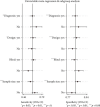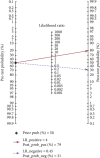Diagnosis Test Meta-Analysis for Apolipoprotein E in Alzheimer's Disease
- PMID: 33101544
- PMCID: PMC7569444
- DOI: 10.1155/2020/6486031
Diagnosis Test Meta-Analysis for Apolipoprotein E in Alzheimer's Disease
Abstract
Objective: To evaluate the diagnostic value of apolipoprotein E (APOE) gene in Alzheimer's disease (AD).
Methods: Databases including PubMed, EMBASE, Google Scholar, Wanfang Med online, China National Knowledge Infrastructure (CNKI), and China Biomedical Literature Database (CBM) were searched for literatures in English or Chinese. No limitations on the date. The sensitivity, specificity, likelihood ratio, and diagnostic odds ratio were pooled for meta-analysis. The symmetric receiver operator characteristic curve (SROC) and Fagan's Nomogram were drawn, and metaregression and subgroup analysis were used to explore the source of heterogeneity.
Results: A total of 13 studies, including 2662 cases and 8843 controls, were analyzed. The combined sensitivity (SEN) was 0.62 (95% CI (0.58-0.66)), specificity (SPE) was 0.84 (95% CI (0.81-0.86)), the positive likelihood ratio was 3.8 (95% CI (3.3-4.3)), and the negative likelihood ratio was 0.45 (95% CI (0.41-0.49)). The area under the ROC curve was 0.80, and the diagnostic ratio (DOR) was 8. Neither publication bias was detected in Deeks' funnel plot, nor threshold effect was shown in the SROC. Metaregression analysis showed that the diagnostic methods, experimental design, and sample size contributed to the heterogeneity in SEN, while the diagnostic methods, experimental design, blind evaluation on test results, and sample size contributed to the heterogeneity in SPE. When the pretest probability was set as 50%, the posterior probability in Fagan's Nomogram was 79%, the positive likelihood ratio (LRP) was 5, and the negative likelihood ratio (LRN) was 0.42.
Conclusions: AD could neither be confirmed nor excluded by the APOE genotype test. The sensitivity and specificity of the APOE gene test were relatively low in the diagnosis of AD. The diagnostic value of APOE ε4 gene in AD was moderate; it might play an important role in the prevention of AD.
Copyright © 2020 Xuan Xiong et al.
Conflict of interest statement
The authors declare that they have no conflicts of interest.
Figures






Similar articles
-
A Systematic Review and Meta-Analysis Comparing FAST and BEFAST in Acute Stroke Patients.Front Neurol. 2022 Jan 28;12:765069. doi: 10.3389/fneur.2021.765069. eCollection 2021. Front Neurol. 2022. PMID: 35153975 Free PMC article.
-
A systemic review and meta-analysis comparing the ability of diagnostic of the third heart sound and left ventricular ejection fraction in heart failure.Front Cardiovasc Med. 2022 Oct 6;9:918051. doi: 10.3389/fcvm.2022.918051. eCollection 2022. Front Cardiovasc Med. 2022. PMID: 36277783 Free PMC article.
-
The diagnostic performance comparison between T2 mapping and Dixon against the activity of thyroid-associated ophthalmopathy: a systematic review and meta-analysis.Front Endocrinol (Lausanne). 2024 Dec 12;15:1502296. doi: 10.3389/fendo.2024.1502296. eCollection 2024. Front Endocrinol (Lausanne). 2024. PMID: 39726842 Free PMC article.
-
A systematic review and meta-analysis comparing the diagnostic capability of automated breast ultrasound and contrast-enhanced ultrasound in breast cancer.Front Oncol. 2024 Jan 9;13:1305545. doi: 10.3389/fonc.2023.1305545. eCollection 2023. Front Oncol. 2024. PMID: 38264749 Free PMC article.
-
Utility of the apolipoprotein E genotype in the diagnosis of Alzheimer's disease. Alzheimer's Disease Centers Consortium on Apolipoprotein E and Alzheimer's Disease.N Engl J Med. 1998 Feb 19;338(8):506-11. doi: 10.1056/NEJM199802193380804. N Engl J Med. 1998. PMID: 9468467
Cited by
-
Alzheimer's disease phenotype based upon the carrier status of the apolipoprotein E ɛ4 allele.Brain Pathol. 2024 Jan;34(1):e13208. doi: 10.1111/bpa.13208. Epub 2023 Aug 30. Brain Pathol. 2024. PMID: 37646624 Free PMC article. Review.
References
-
- Wang H., Yu X. Epidemiological status of Alzheimer's disease in China. Chinese Journal of General Practitioners. 2006;5(6):358–360.
-
- Wang Y., Zhidong X. Progress in the epidemiology of Alzheimer's disease. Chinese Journal of Practical Nervous Diseases. 2015;20:118–119.
-
- Runhui L. Research status of Alzheimer's disease. Journal of Shenyang Medical College. 2013;15(3):129–133.
Publication types
MeSH terms
Substances
LinkOut - more resources
Full Text Sources
Medical
Miscellaneous

